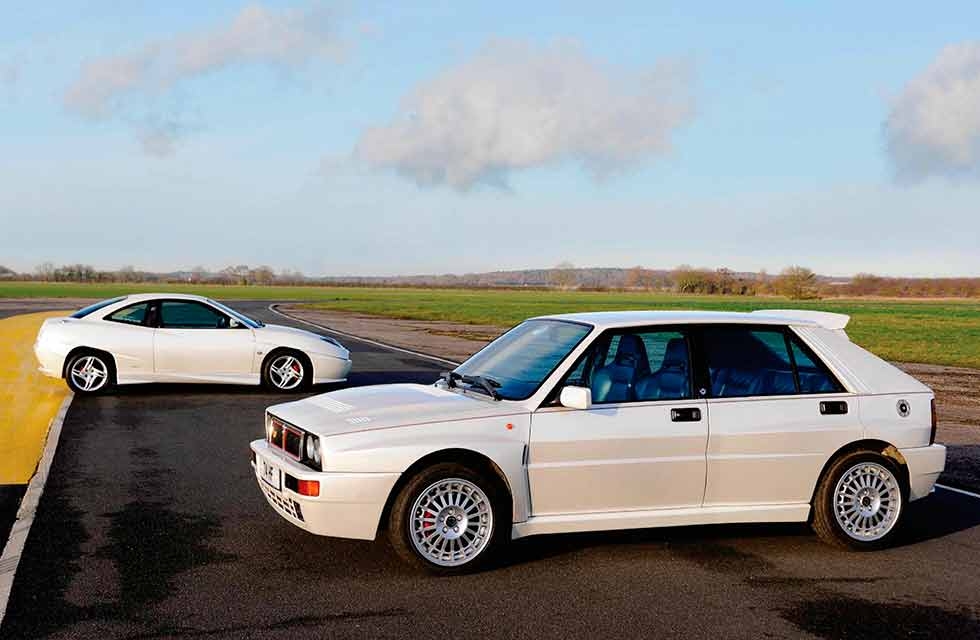
A whiter shade of pearl. Did you know that both the Fiat Coupe and Lancia integrale share the same floorpan? That’s not all – these two 1990s Italian turbo siblings also share the same ultra-rare Pearl White colour scheme. Story by Johnny Tipler. Photography by Michael Ward.
FIAT COUPE 20V TURBO LE VS LANCIA DELTA INTEGRALE EVO
Two Pearl White modern classics face off
Appearances are deceptive. One is apparently a straightforward five-door family hatch, the other’s a whistles-and-bells sports coupe. There’s the paradox, because in fact the slinky coupe with its futuristic styling is the more conventional car, while the family hatch is the rally champ with a list of palmares stretching round the block. Both are idiosyncratic modern classics. What better opportunity to tell their story than to bring together one of each in highly unusual Pearl White paint?

We’ve come to Blyton Aerodrome, a test track frequented by the Ginetta factory and autocross racers. Because of its gravelled off-road extensions, any flying is scotched. The perimeter road is narrow, too, compared with other disused airfields like Snetterton.
We have two amazing cars here today: a Fiat Coupe 20V Turbo LE and a Lancia Delta HF integrate Evolution. The Fiat has been brought up from Leicestershire by Johnny Cartlidge, proprietor of Midlands Car Servicing and a recognised expert on the model. The Lancia belongs to integrate god, Steve Smith, who’s run Walkers Garage at Northallerton, near Croft circuit, for 45 years.
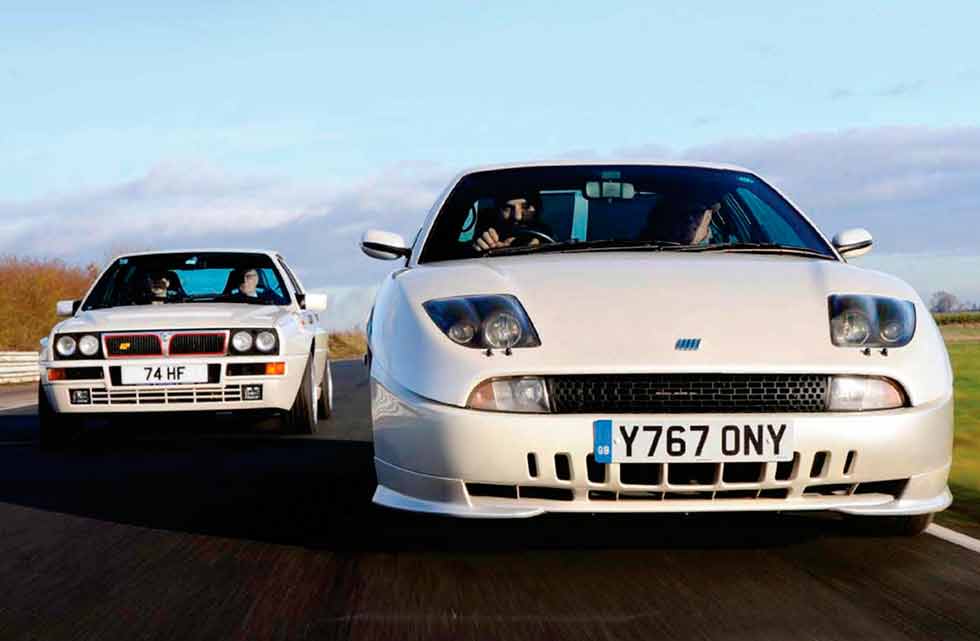
“That’s boy and man really,” laughs Steve, “and appropriately enough my son Ben is taking over. It was British Leyland when I was first there, and then we had 12 years with Mitsubishi. The franchise outgrew the country garage, and they wanted glass palaces in the towns.” Steve had always been interested in motorsport, so when Lancia became available in 1988, he became a franchised dealer. He first went rallying in 1989 with a Delta 4WD, and has done the RAC Rally five times and finished every time – in the top 20, too, co-driven by Brian Hughes. The height of connoisseurship is that he used to run an ex-Juha Kankkunen (four-time WRC champion, twice in Lancias) integrate.
“The Fiat feels like a contemporary coupe to drive… The Integrale wears its heart on its sleeve”
Steve is inextricably linked with the integrale. “When Lancia stopped building integrates I ordered 10 cars, and we sold them all. After that we were buying them from the continent and I was fetching them pretty much by the transporter load.” And the car we have here today? “I bought it from Croatia, though it’s an Italian car. A customer bought it in Italy before Croatia was in the EU. 20 years later, we negotiated a price and my wife and I flew out and drove it home.” So, this is the keeper then.
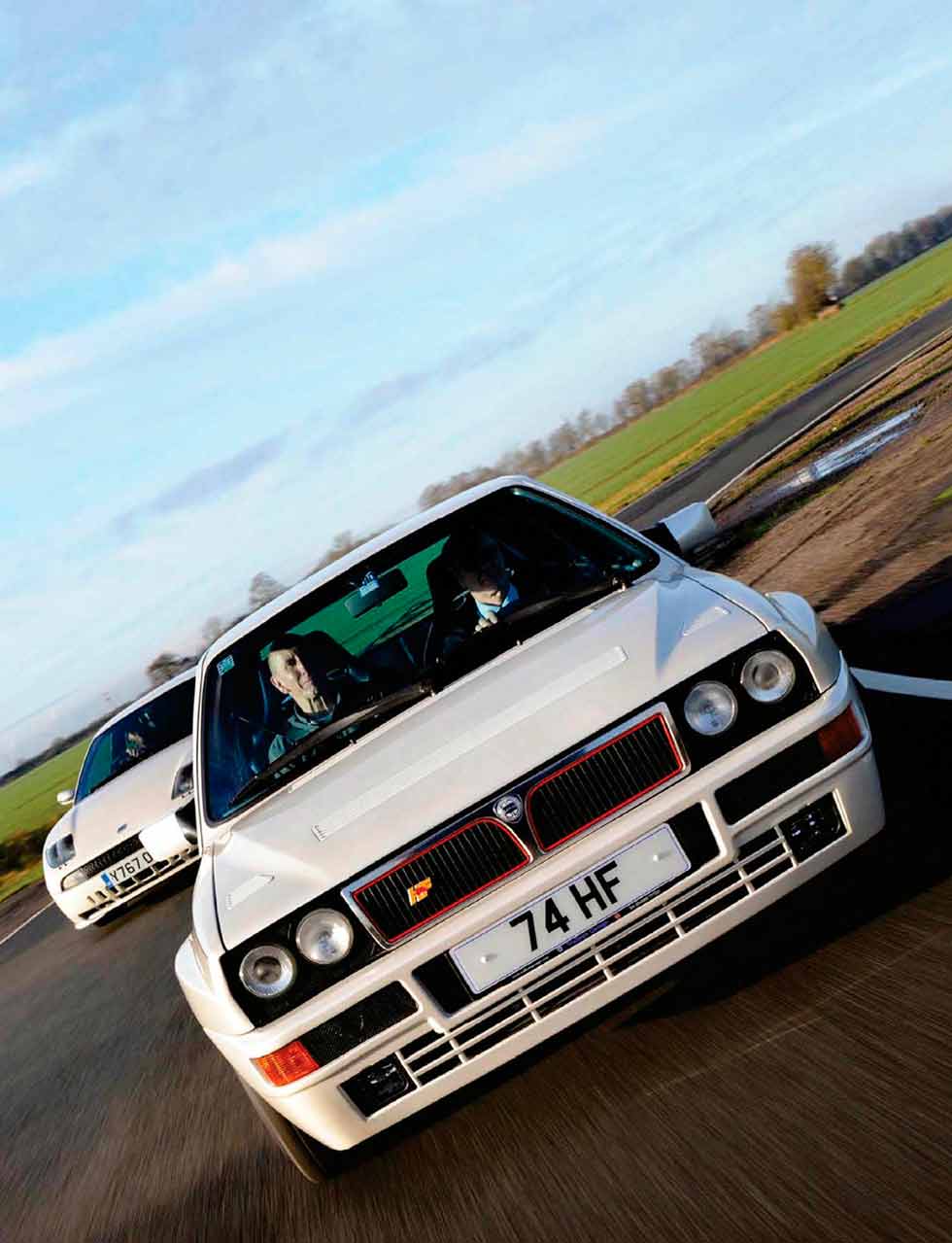
Steve continues: “The wheel on the Evolution is a copy of the wheel that Lancia used when rallying, a Speedline competition wheel with a pattern called Monte Carlo. It’s on Pirelli P-Zero Neros, 205/45 ZRi6s all round. Some came with Pirellis, some with Michelins; I’m a Michelin man because I was a Michelin-supported rally driver, so I have to say Michelin are by far the best! The Evo 1 has 15-inch wheels, but Michelin stopped making that size.”
The integrale dash is all 1970s linear, rectangular shapes, analogue and digital, the product of Giorgetto Giugiaro’s ItalDesign. Even the shape of the mirrors and door handles are redolent of that decade. The smoky Royal Blue colour of the figure- hugging leather seats is rather special, and unique to Pearl White cars. Even the neat Momo wheel is a match, helping coordinate the whole cabin in its very 1970s way.
Johnny Cartlidge is totally immersed in the Fiat Coupe. He started off as an apprentice at a Fiat dealership, working for four years exclusively on Fiat Coupes and the five- cylinder engine, becoming intimately familiar with the model’s teething problems, from Brembo brake squeal to cracked turbo manifolds. “There were issues with auxiliary belt failures, causing havoc with the timing and buckling valves, which is a lengthy and expensive head-off job. Oil coolers are prone to corrosion, and with 7.0 bar of oil pressure on a cold day, if it was corroded right through it would purge all five litres of oil in 15 to 20 seconds, so there’s not a lot of warning.”

Pearl White was never available for Fiat Coupes in the UK, though it could be specified in the European market. So all Pearl white ones are left-hand drive, with the odd exception being an ex-military car owned by someone stationed in Germany. It suits it rather well, the white paint enabling you to see all the swage lines clearly. As for the quirky styling cues, put the design down to Chris Bangle, the talented if controversial American who worked at Centro Stile in 1990 and penned this model. The Pininfarina badge on the flanks reflects little more than the cabin ergonomics and furnishings. Inside, everything has a nice feel to it, from the door handles to the gearknob and steering wheel. There’s some fascinating detailing: aluminium push-button start, white dials and clock, red stitching on the interior, red strut brace, red rocker top and red callipers. Just the Turbo Plus models and the LE Limited Editions had strut braces. The six-speed gearbox is standard, while the split-rim wheels have double the spokes compared to early solid four-spoke wheels. The side skirts and the lips on the front bumper are standard on these top-line models, whereas the normal 20-valve Turbo is five-speed with no skirts, and its Brembo callipers are in silver, with a silver cam cover.
The Coupe’s Pininfarina dashboard is avant-garde, simple and elegant. Everything is functional, and all the switches are well laid out. Comfort wise, the seats are very good, supportive without being constrictive, and containing airbags too – which raises another issue. Johnny points out that this model is actually two inches broader than other Coupes, the additional width manifest in the sills and door-shuts. “The actual body is wider. It’s a requirement of the airbag that, if it does deploy, there has to be a set distance between seat and door to prevent it ripping the seat out of the floor. The seat airbags were a very expensive factory extra, and very unusual.”
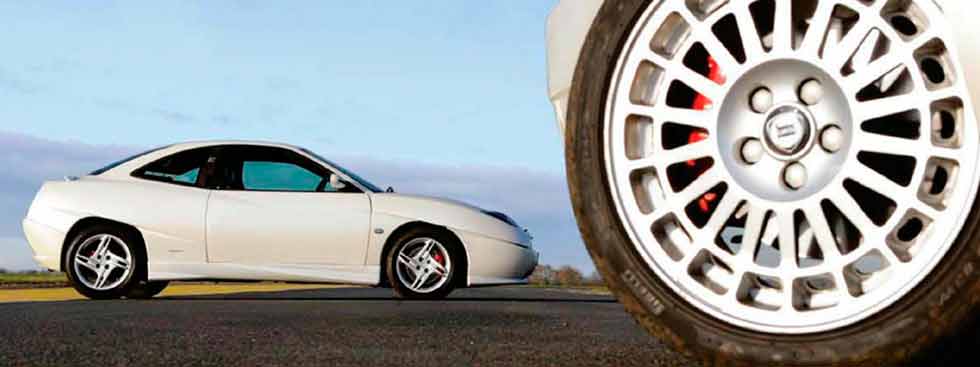
How practical is the Coupe? Johnny’s kids are aged between six and 18. “The boot’s adequate, and you can get a pushchair in there, and a couple of baby seats in the back. It is very well built, and that’s reflected in their values relative to a lot of cars of that era, even German and Japanese models.”
And yet… Here comes the shocker: the underpinnings are annexed from the Fiat Strada chassis. A ripple of consternation bubbles up from the assembled Italophiles trackside at Blyton. “We always said it was built on a Tipo chassis,” says Johnny. “Apparently not: like the integrate, which harks back to the original Delta of 1979, the Coupe’s DNA was also spawned by the Ritmo/Strada floorpan of 1979.”
Our Pearl White Coupe is on Michelin Pilot Sport 3 205/50 16s all round. As for the driving, with the weight up front and 220hp on tap, I anticipate understeer, which Johnny is quick to rebut. “Weight distribution is about 60/40 front to rear, and provided the suspension has been refreshed and the tyres are good, these cars handle very well, and they put the power down very well too.”
The five-cylinder has a very distinctive sound, not as refined as a ‘six’, but not as raw as an in-line four. But the way the compression stroke is ordered means you’ve always got a cylinder on compression. When it starts up it’s quite quiet and innocuous until you start flooring it. The power of the turbo comes early on at 2000rpm, with the lovely gurgling of the ‘Fire’ five-cylinder engine in the background. There’s the unmistakable whistle of the dump valve opening. The steering is very precise, though the gearshift is quite a long throw. The chassis is an acquired taste, and you can feel the weight of it in the corners.
Johnny commentates as we circulate Blyton’s trackscape: “The 2.0-litre 20-valve engine is very punchy low down, and the duration especially in third gear is immense. It’s such a long spread of power through gears, which you don’t get in a lot of modern cars. Keep them revved, because the fun really starts after 4500-5000rpm.”
Acceleration is really sharp through the gears, and it anchors up very nicely. Turn-in is pretty accurate, though I’m physically driving it through the corners, leaning on the tyres and the limited-slip diff. Do I leave it running to cool the turbo when we come to a standstill? “With a cast-iron block you don’t need to do that; just keep it off boost at about 2000rpm, do your slowing down lap and then pull in and turn it off. Because it’s cast iron, it retains heat very well.”

The integrate is a quite different kettle of fish. Immediately the suspension seems firmer and the whole car lighter, despite its five-door configuration. “The standard car is best,” says Steve. “A lot of people bring their cars in and want to do this and that, but mucking about with the suspension simply spoils them: the standard ones are fabulous.” It is so nifty through the sharper corners and I keep the power on through the bends. It feels perfectly balanced, helped by drive split 47/53 front to rear. The feedback is so delicate and I can sense all the nuances of the corners acutely through the steering. Going progressively faster, I’m aware that the power is right there, no matter how low down I’m shifting. Steve advocates listening to the sound of the engine rather than keeping an eye on the boost gauge. “Generally, if you’re competing, when you get to a straight you might have a chance to glimpse things, but you’re relying on warning lights, really.”
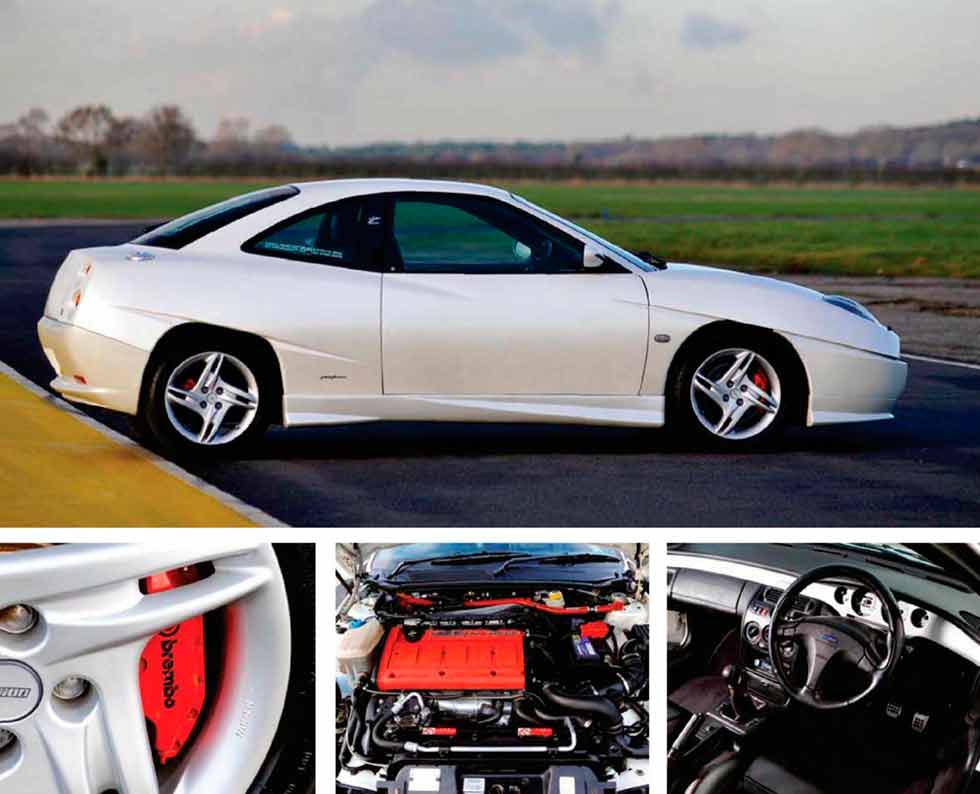
The rallying pedigree could take on a new slant, potentially. The cut-off for eligibility for the Monte Carlo Rallye Historique is up to 1980 now, so it can’t be long before the integrate becomes eligible for historic rallying, and that really will set the cat among the pigeons: “There are no four-wheel drive cars currently in it,” says Steve, “so I think it will happen, though everybody that’s rallying Ford Escorts won’t be happy! They say it will ruin historic rallying, but logically they can’t exclude quattros and integrates just because they’re ultra-competitive.”
Since this is a back-to-back-appraisal, let’s look at the performance figures. The integrate Evo has 215hp but rushes from o-62mph in 5.7 seconds, against the 220bhp Coupe’s 6.3 seconds. On the other hand, the integrale’s top speed is 137mph, while the Coupe’s top whack is a more substantial 155mph. In terms of modernity, the Coupe feels like a contemporary front-drive GT to drive, while the Pininfarina cabin endows it with a timeless quality, and perhaps its quirky styling gives it the aesthetic edge, too. Stylistically and technically, the integrale wears its heart on its sleeve; the body shape and cabin furniture anchor it in time, although its four-seat practicality betters the Coupe’s. In the drivability stakes, the Coupe has to be worked, which is rewarding in itself. But the integrale just dances, effortlessly, and you can partner it as you like. No question, though, you’d happily ‘skip the light fandango’ with either.
Both cars essentially owe their DNA to the same Fiat-based floorpan but feel very different to each other
CONTACT Midlands Car Servicing, Shepshed, Leics. Tel: 07905 143578. Web: www.midlandscarservicing.co.uk
CONTACT Walkers Garage, Northallerton, North Yorkshire DL7 9HT. Tel: 01609 777221. Web: www.walkersgarage.com
| CAR: | LANCIA INTEGRALE EVO | FIAT COUPE 20V TURBO |
| ENGINE: | 1995cc 4-cylinder 16-valve turbo | 1998cc 5-cylinder 20-valve turbo |
| BORE/STROKE: | 84mm x 90mm | 82mm x 75.65mm |
| COMPRESSION RATIO: | 8.0:1 | 10.0:1 |
| POWER: | 215hp @ 5750rpm | 220hp @ 5750rpm |
| TORQUE: | 232lb ft (314Nm) @ 2500rpm | 229lb ft (310Nm) @ 5750rpm |
| TRANSMISSION: | Five-speed manual, all-wheel drive | Six-speed manual, front-wheel drive |
| BRAKES: | Discs all round | Discs all round |
| TYRES: | 205/45 ZR16 (front), 205/45 ZR16 (rear) | 205/50 16 (front) 205/50 16 (rear) |
| DIMENSIONS: | 3900mm (L), 1770mm (W), 1365mm (H) | 4250mm (L), 1760mm (W), 1340mm (H) |
| KERB WEIGHT: | 1340kg | 1310kg |
| TOP SPEED: | 137mph | 155mph |
| 0-62MPH: | 5.7sec | 6.3sec |





